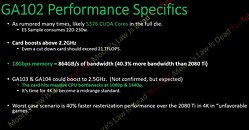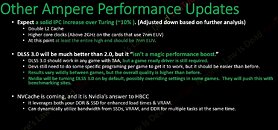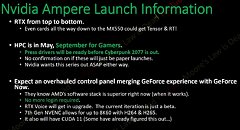- Joined
- Oct 9, 2007
- Messages
- 47,912 (7.37/day)
- Location
- Dublin, Ireland
| System Name | RBMK-1000 |
|---|---|
| Processor | AMD Ryzen 7 5700G |
| Motherboard | Gigabyte B550 AORUS Elite V2 |
| Cooling | DeepCool Gammax L240 V2 |
| Memory | 2x 16GB DDR4-3200 |
| Video Card(s) | Galax RTX 4070 Ti EX |
| Storage | Samsung 990 1TB |
| Display(s) | BenQ 1440p 60 Hz 27-inch |
| Case | Corsair Carbide 100R |
| Audio Device(s) | ASUS SupremeFX S1220A |
| Power Supply | Cooler Master MWE Gold 650W |
| Mouse | ASUS ROG Strix Impact |
| Keyboard | Gamdias Hermes E2 |
| Software | Windows 11 Pro |
PC hardware focused YouTube channel Moore's Law is Dead published a juicy tech-spec reveal of NVIDIA's next-generation "Ampere" based flagship consumer graphics card, the GeForce RTX 3080 Ti, citing correspondence with sources within NVIDIA. The report talks of big changes to NVIDIA's Founders Edition (reference) board design, as well as what's on the silicon. To begin with, the RTX 3080 Ti reference-design card features a triple-fan cooling solution unlike the RTX 20-series. This cooler is reportedly quieter than the RTX 2080 Ti FE cooling solution. The card pulls power from a pair of 8-pin PCIe power connectors. Display outputs include three DP, and one each of HDMI and VirtualLink USB-C. The source confirms that "Ampere" will implement PCI-Express gen 4.0 x16 host interface.
With "Ampere," NVIDIA is developing three tiers of high-end GPUs, with the "GA102" leading the pack and succeeding the "TU102," the "GA104" holding the upper-performance segment and succeeding today's "TU104," but a new silicon between the two, codenamed "GA103," with no predecessor from the current-generation. The "GA102" reportedly features 5,376 "Ampere" CUDA cores (up to 10% higher IPC than "Turing"). The silicon also taps into the rumored 7 nm-class silicon fabrication node to dial up GPU clock speeds well above 2.20 GHz even for the "GA102." Smaller chips in the series can boost beyond 2.50 GHz, according to the report. Even with the "GA102" being slightly cut-down for the RTX 3080 Ti, the silicon could end up with FP32 compute performance in excess of 21 TFLOPs. The card uses faster 18 Gbps GDDR6 memory, ending up with 863 GB/s of memory bandwidth that's 40% higher than that of the RTX 2080 Ti (if the memory bus width ends up 384-bit). Below are screengrabs from the Moore's Law is Dead video presentation, and not NVIDIA slides.



As for performance, the "GA102" based prototype is allegedly clocking 40 percent higher performance than the RTX 2080 Ti at 4K UHD resolution in poorly optimized games, 50% higher performance on optimized games, and up to 70 percent performance in the "best case scenario" (a game that's been optimized for the "Ampere" architecture). We know from older leaks that by increasing the number of streaming multiprocessors, NVIDIA is doubling the CUDA core : RT core ratio compared to Turing, resulting in more RT cores per tier; and increased ray-tracing performance.
Each "Ampere" RT core is able to process 4x more intersections per unit clock-speed than "Turing." The tensor core count is also reportedly going to see an increase. The focus on ray-tracing and AI performance increase could give game developers the freedom to cram in more RTX effects per title, letting users disable what they want on older "Turing" cards. Performance limitations on "Turing" made developers choose from the RTX feature-set on what to implement. With "Ampere," NVIDIA could introduce DLSS 3.0, an updated image quality and performance enhancement. NVIDIA could resurrect a hybrid memory technology similar to AMD's HBCC, called NVCache, which spreads video memory across the video memory, the system memory, and flash-based storage.


Lastly, there's more clarity as to what silicon fabrication process NVIDIA could use. Apparently, NVIDIA will spread its product stack between two kinds of 7 nm-class nodes. The higher-end ASICs, such as the "GA102" and "GA103," could be built on 7 nm EUV nodes such as the TSMC N7+; while the smaller ASICs could be built on conventional DUV-based 7 nm-class nodes such as the N7P or even N7.
Don't pull your wallets out just yet. The launch schedule points to May 2020 (GTC) being focused on HPC parts based on "Ampere," such as the Tesla A100 and DGX A100 system.
In September 2020, NVIDIA will hold a separate event specifically to launch the next-generation GeForce, very close to "Cyberpunk 2077" release.
View at TechPowerUp Main Site
With "Ampere," NVIDIA is developing three tiers of high-end GPUs, with the "GA102" leading the pack and succeeding the "TU102," the "GA104" holding the upper-performance segment and succeeding today's "TU104," but a new silicon between the two, codenamed "GA103," with no predecessor from the current-generation. The "GA102" reportedly features 5,376 "Ampere" CUDA cores (up to 10% higher IPC than "Turing"). The silicon also taps into the rumored 7 nm-class silicon fabrication node to dial up GPU clock speeds well above 2.20 GHz even for the "GA102." Smaller chips in the series can boost beyond 2.50 GHz, according to the report. Even with the "GA102" being slightly cut-down for the RTX 3080 Ti, the silicon could end up with FP32 compute performance in excess of 21 TFLOPs. The card uses faster 18 Gbps GDDR6 memory, ending up with 863 GB/s of memory bandwidth that's 40% higher than that of the RTX 2080 Ti (if the memory bus width ends up 384-bit). Below are screengrabs from the Moore's Law is Dead video presentation, and not NVIDIA slides.



As for performance, the "GA102" based prototype is allegedly clocking 40 percent higher performance than the RTX 2080 Ti at 4K UHD resolution in poorly optimized games, 50% higher performance on optimized games, and up to 70 percent performance in the "best case scenario" (a game that's been optimized for the "Ampere" architecture). We know from older leaks that by increasing the number of streaming multiprocessors, NVIDIA is doubling the CUDA core : RT core ratio compared to Turing, resulting in more RT cores per tier; and increased ray-tracing performance.
Each "Ampere" RT core is able to process 4x more intersections per unit clock-speed than "Turing." The tensor core count is also reportedly going to see an increase. The focus on ray-tracing and AI performance increase could give game developers the freedom to cram in more RTX effects per title, letting users disable what they want on older "Turing" cards. Performance limitations on "Turing" made developers choose from the RTX feature-set on what to implement. With "Ampere," NVIDIA could introduce DLSS 3.0, an updated image quality and performance enhancement. NVIDIA could resurrect a hybrid memory technology similar to AMD's HBCC, called NVCache, which spreads video memory across the video memory, the system memory, and flash-based storage.


Lastly, there's more clarity as to what silicon fabrication process NVIDIA could use. Apparently, NVIDIA will spread its product stack between two kinds of 7 nm-class nodes. The higher-end ASICs, such as the "GA102" and "GA103," could be built on 7 nm EUV nodes such as the TSMC N7+; while the smaller ASICs could be built on conventional DUV-based 7 nm-class nodes such as the N7P or even N7.
Don't pull your wallets out just yet. The launch schedule points to May 2020 (GTC) being focused on HPC parts based on "Ampere," such as the Tesla A100 and DGX A100 system.
In September 2020, NVIDIA will hold a separate event specifically to launch the next-generation GeForce, very close to "Cyberpunk 2077" release.
View at TechPowerUp Main Site





